U n i v e r s i t é Y O R K U n i v e r s i t y
ATKINSON FACULTY OF LIBERAL AND PROFESSIONAL STUDIES
SCHOOL OF ANALYTIC STUDIES & INFORMATION TECHNOLOGY
S C I E N C E A N D T E C H N O L O G Y S T U D I E S
NATS 1800 6.0 SCIENCE AND EVERYDAY PHENOMENA
ATKINSON FACULTY OF LIBERAL AND PROFESSIONAL STUDIES
SCHOOL OF ANALYTIC STUDIES & INFORMATION TECHNOLOGY
S C I E N C E A N D T E C H N O L O G Y S T U D I E S
NATS 1800 6.0 SCIENCE AND EVERYDAY PHENOMENA
Lecture 15: Inevitable Illusions
| Prev | Next | Search | Syllabus | Selected References | Home |
Topics
- One of the tacit assumptions we make everyday is that the world we perceive and act on is the world out there. Our senses are like a window, that simply opens on the world as it is. We seldom stop to ask whether, say, a fly or a cat perceive the same world as we do. Yet we know that certain diseases and chemicals can profoundly distort our 'normal' representation of the world. But it's not just a question of perception. We usually consider our judgments too to be 'objective.' It is true that somehow we realize judgments have a subjective component, but in certain situations such subjectivity is deemed to be minimal, negligible. Let me propose a little experiment that, as far as I know, was first suggested by the sociologist Ward Edwards (see, e.g. Ward Edwards, Dynamic Decision Theory and Probabilistic Information Processing, Human Factors, 4:59--73, 1962). Consider two identical, glass jars. Let's call them A and B. A contains 600 red marbles and 400 blue marbles, while Bcontains 400 red marbles and 600 blue marbles. The marbles in both jars have been thoroughly mixed. I now hide the two jars, and, out of your sight, I extract a handful—say, 10—of marbles from one of the jars. I then show you the 10 marbles. It turns out that 6 of them are red and 4 are blue. Question: how likely is it that the sample was taken from jar A? Clearly, it is 'possible' that the sample comes from either jar. But, how 'probable' is it that it comes from jar A? Mind you, I am not asking you to 'calculate' such probability, but simply to use your gut judgment. As a guideline, an answer of 50/100 would imply you consider it equally likely that the sample was extracted from either jar. An aswer of 100/100 would imply you consider it certain that the sample was taken from A. In other words, your answer will be a number between 50 and 100. We will do the experiment in class, and discuss the results, and what the 'correct' answer is. For the moment, let me predict that you will be very surprised. Your gut judgment is not as accurate as you thought. Not just your judgment! Ward Edwards showed that such decision making errors are present in different cultures, in different historical periods, both at the level of the individual and of social and business institutions.
-
The questions raised by Ward Edwards are serious, as they seem to suggest that the world out there may be more
of a mental construction than we care to admit. This is confirmed by even a cursory survey of perceptual or
sensory illusions. Consider the famous Hering illusion:
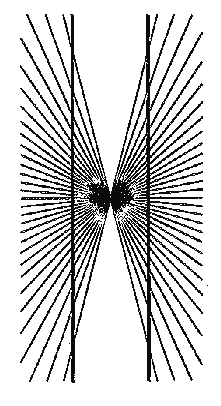
The Hering Illusion
Just about everybody would claim that the two vertical lines are anything but 'straight' and 'parallel.' Yet, they are! Here is another beautiful illusion: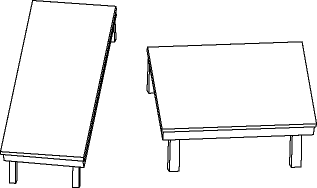
Roger Shepard's Tables
The two tabletops appear to have quite different dimensions, yet they are identical, as you can quickly verify with a ruler. Read The Minds Eye. Finding Truth In Illusion.
This is a nice article on Shepard's work, and it includes some of the illusions he created.
Here is a rather spectacular illusion, involving colors, devised by Edward Adelson
The Minds Eye. Finding Truth In Illusion.
This is a nice article on Shepard's work, and it includes some of the illusions he created.
Here is a rather spectacular illusion, involving colors, devised by Edward Adelson
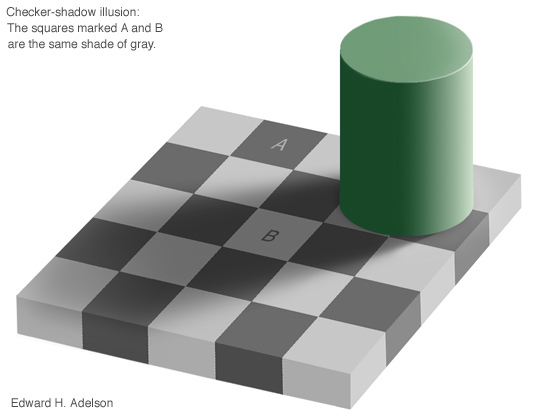
The Checkerboard Illusion
Visual illusions happen not only in psychology textbooks, but in everyday life too. Consider for example the so-called moon llusion. That this is an illusion can be easily established: just measure (how?) the diameter of the moon at the horizon and at the zenith—they are identical.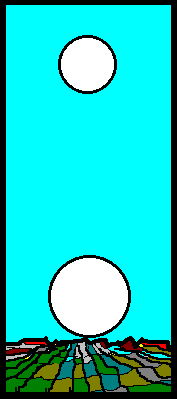
The Moon Illusion
"For many centuries, scientists have been puzzled by the illusion that the full moon at the horizon usually looks larger than it does later, at higher elevations toward the zenith of the sky. Many explanations (theories) have been offered. But, it is fair to say that the two dozen (or so) scientists most familiar with current research on the illusion have not yet accepted any one theory. The jury is still out." [ from The Moon Illusion Explained ]. Here is an intriguing hint. The image below represents what is known as the Ebbinghaus illusion or Titchner's circles.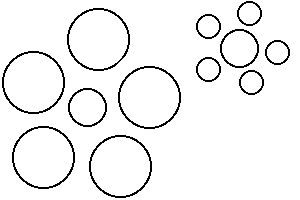
The Classic Ebbinghaus Illusion (Titchner's Circles).
"In the patterns at the left, the two central circles are the same size, but their linear sizes on the page look unequal, because the angular size for the circle surrounded by smaller circles looks slightly larger (say about 10% larger) than the angular size for the circle surrounded by larger circles (McCready, 1985)."
[ See The Moon Illusion Explained ]. Notice that the moon does look smaller or larger depending on where it is on its orbit around the earth. Read John Walker's Inconstant Moon: The Moon at Perigee and Apogee. This fact, however, does not explain the moon illusion, since in one night the distance between the moon and the earth hardly changes at all. -
The number of visual illusions is enormous and you can visit several good websites featuring galleries
of such images. Here are just a few starting points:
- Akiyoshi's Illusion Pages
- M C Escher
- Exploratorium Exhibits
- Hall of Illusions
- Illusions
- Peter Kaiser's Fun Things from his beautiful web book The Joy of Visual Perception
- MIT's Perceptual Science Group
- Scott Owen's Visual Illusions
- Vision Science: Demonstrations
- What We See Is What We Expect to See
- Wikipedia's article on Optical Illusion
- Illusions are not just visual. Auditory, tactile, olfactory and gustatory illusions are also common. A good place to explore is Visual and Auditory Illusions where you will find many demonstrations and solid background information. Note, in particular, the text and applet listed under "Shepard's Tones." Another type of illusion, much more complicated, is the common déjà vu experience. See for example What is Déjà Vu?.
-
Having biefly surveyed the data, we must now turn to the research aimed at understanding why visual and
other perceptual illusions are there to begin with. Do they serve any function? or, why hasn't evolution
eliminated them? or, even if we can't answer the first two questions, is there anything useful about them?
Here's what Roger Shepard has to say, referring to his own drawings of visual illusions:
"The drawings [ … ] achieve their effects by means of various visual tricks. But to call them tricks is not to imply that they are without psychological significance. The tricks work by taking advantage of fundamental perceptual principles that have been shaped by natural selection in a three-dimensional world. Our ability to make pictures, which emerged only recently on an evolutionary time scale, enables us to present the eyes with visual patterns that systematically depart from the patterns that we and our ancestors experienced in nature. In considering the ways pictures can trick the eye, we can gain insight into the nature and ultimate source of the principles of visual perception."
And here's an even stronger statement by Scott Owen:
[ quoted in The Minds Eye. Finding Truth In Illusion ]"Visual illusions have provided much of the information on which theories of the functioning of organic visual systems are based [ … ] All these examples show the existence of a system capable of deductive reasoning and consistency maintenance operating below the level of our conscious awareness."
But what about the physiological mechanisms responsible for visual illusions? Unfortunately, different mechanisms are involved in different illusions, and there is no room within the scope of this course to review them all. I will therefore limit myself to a couple of examples. The first one refers to a property of the visual system called 'size constancy': despite the fact that the same object casts images of very different size on the retina depending on its distance from the eye, the brain is capable of compensating for that. See Size Constancy in a Photograph for a very nicely done demonstration. If such compensation didn't take place, we would consider a distant elephant an insect. (I will have more to say about this a little later.) Consider now the 'Ponzo illusion' (using Roger Shepard's version)
[ from Visual Illusions ]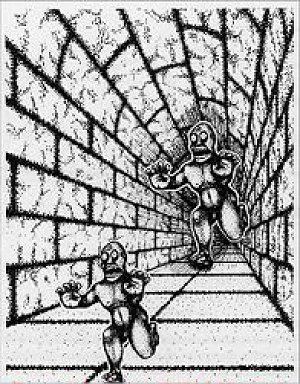
The Ponzo Illusion: Who is Bigger?
The reason why we are tricked is that the context of the two figures (perspective) alerts the brain to compensate for distance. In other words the brain magnifies the upper figure, because it interprets it as being farther away. This is also the explanation of the illusion created by Roger Shepard's Tables. The explanation of other illusions is usually more complicated. For example, an understanding of the 'Checkerboard Illusion' requires a rather detailed knowledge of the structue and function of the retina and of the visual cortex. A good introduction to these is John Krantz's tutorial on Receptive Fields. A receptive field is an area of the retina or of the visual cortex which, when stimulated, triggers the response of specific and specialized neurons. Receptive fields are physiological feature detectors, which respond to contrast, edges, gradients, etc. For detailed explanations of various illusions, see for example Tricking the Eye or Trapping a Reflex?, which reviews the work of Dale Purves; and an article by Osvaldo da Pos, Visual Illusions and Effects. The spectrum of visual illusions is quite broad, and some of them require more than physiological exlanations. This is true, for example, of the many illusions involving a choice between figure and ground. Here is a classical example first introduced by Edgar Rubin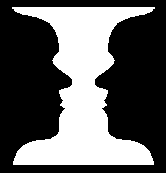
The Rubin Illusion. One Vase or Two Faces?
"Images such as this are ambiguous concerning figure and ground. Is the figure a white vase (or goblet, or bird-bath) on a black background or silhouetted profiles on a white background? Perceptual set operates in such cases and we tend to favour one interpretation over the other (though altering the amount of black or white which is visible can create a bias towards one or the other). When we have identified a figure, the contours seem to belong to it, and it appears to be in front of the ground."
[ from Daniel Chandler, Visual Perception 6 ] The figure-ground ambiguity plays a very important role in the way we interpret the world. Think: we spend at least the first few months of our lives learning the basics—how to identify objects as distinct from their background. Read Figure/Ground
Figure/Ground
-
To conclude this lecture we want now to briefly consider a couple of important questions: are visual illusions
universal, in the sense that all human beings experience them? are visual illusions universal, in the sense that
other species experience them too?
Here is a sort of answer to the first question:
"The anthropologist Colin Turnbull described what happened in the former Congo in the 1950s when a BaMbuti pygmy, used to living in the dense Ituri forest (which had only small clearings), went with him to the plains:
In the same article, Chandler also writes:'And then he saw the buffalo, still grazing lazily several miles away, far down below. He turned to me and said, "What insects are those?" At first I hardly understood, then I realized that in the forest vision is so limited that there is no great need to make an automatic allowance for distance when judging size. Out here in the plains, Kenge was looking for the first time over apparently unending miles of unfamiliar grasslands, with not a tree worth the name to give him any basis for comparison… When I told Kenge that the insects were buffalo, he roared with laughter and told me not to tell such stupid lies. (Turnbull 1963, 217).'
Because Kenge had no experience of seeing distant objects he saw them simply as small."
[ quoted in Cultural and Environmental Factors ]"Experiments reported in 1966 by Segall, Campbell and Herskovitz suggested that the Müller-Lyer illusion may be absent or reduced amongst people who grow up in certain environments. They tested some Zulu people in South Africa who, at the time, lived in circular huts with arched doorways and had little experience of Western rectangular buildings. The Zulus seemed less affected by the Müller-Lyer illusion. The argument is that these people lived in a 'circular culture' whereas those who are more subject to the illusion live in a 'carpentered world' of rectangles and parallel lines (Segall, Campbell & Herskovits 1966). Europeans and Americans are more likely to interpret oblique and acute angles as displaced right angles and to perceive two-dimensional drawings in terms of depth."
Chandler's conclusion is that "the perception of depth, and especially the cultural factors touched on briefly here, suggest that visual perception is in part at least learned." Further readings should include D R Price-Williams, ed., Cross-Cultural Studies; Selected Readings, Penquin Books 1969. What about the second question—do species other than man experience visual illusions? The answer is that we have experimental evidence that this is so at least in certain species such as cats, monkeys, apes, etc. Here is what psychologist Dr. Robert Cook states in an article well worth reading: Visual Perception, which is one of the readings for a course on Animal Cognition & Learning at Tufts University."One way is to test whether animals experience our visual illusions, since the "misperceptions" invoked by such stimuli help to directly reveal the visual system's active contribution to perception. Pigeons seem to suffer from some of the same geometric illusions as humans, such as the Ponzo and Mueller-Lyer illusions (Fujita, Blough, & Blough, 1991; Malott & Malott, 1970). Besides indicating a common perception, this type of similarity suggests even further that some of the underlying processes involved are also the same."
Quite revealing in this respect is also a 1966 MIT Research press release entitled Brain Processing of Visual Information, Finally I should mention the pioneering research conducted by D Hubel and T Wiesel on cats. and a famous article they published in 1966, Receptive Fields, Binocular Interaction and Functional Architecture in the Cat's Visual Cortex, in Journal of Physiology, 160, 106 154. In other words, at least some animals experience visual illusions just as we do.
Readings, Resources and Questions
- Read Did You See the Gorilla? then visit the Visual Cognition Lab at the University of Illinois.
-
Read James B Calvert's good and general introduction:
 Illusions. Illusions Are a Natural Part of Consciousness.
Illusions. Illusions Are a Natural Part of Consciousness.
- A very good collection is Michael Bach's excellent, well-documented 48 Optical Illusions & Visual Phenomena.
- What are the differences between hallucinations, illusions, and mirages?
- For some remarkable examples of art that illustrates visual illusions, visit Optische Illusionen
- Find and discuss examples of auditory, tactile, olfactory and gustatory illusions.
© Copyright Luigi M Bianchi 2003-2005
Picture Credits: U of Massachusetts · U of California, Irvine
E H Adelson · UW-Whitewater · Psychological Arts · U of Wales
Last Modification Date: 10 January 2006
Picture Credits: U of Massachusetts · U of California, Irvine
E H Adelson · UW-Whitewater · Psychological Arts · U of Wales
Last Modification Date: 10 January 2006